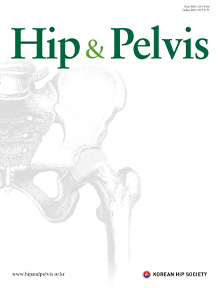Quick links
Related article in
-
Original ArticleDecember 31, 2016
 0
0
 80
80
 17
17

Fucntional and Radiological Outcome of Surgical Management of Acetabular Fractures in Tertiary Care Hospital
Faizan Iqbal, MBBS, Intikhab Taufiq, FCPS, FRCS, Muhammad Kazim Raheem Najjad, FCPS, Naveed Khan, MBBS, Osama Bin Zia, MBBS
Hip Pelvis 2016; 28(4): 217-224AbstractPurpose: Acetabular fractures are mainly caused by trauma and the incidence is rising in developing countries. Initially these fractures were managed conservatively, due to lack of specialized and dedicated acetabulum surgery centres. Our aim is to study the radiological and functional outcomes of surgical management of acetabular fractures in tertiary care hospital.
Materials and Methods: Total 50 patients were enrolled. The patients with acetabular fractures were enrolled between the years 2012 to 2014. Patients were evaluated clinically with Harris hip score (HHS) and radiologically with Matta outcome grading. The factors examined include age, gender, fracture pattern, time between injury and surgery, initial displacement and quality of reduction on the final outcome.
Results: There were 34 males and 16 females. Mean age was 44.20±11.65 years while mean duration of stay was 9.28±2.36 days. Duration of follow-up was 24 months. Most common mechanism of injury was motor vehicle accident (n=37, 74.0%). Open reduction and internal fixation of fractures were performed using reconstruction plates. Mean HHS at 24 months was 82.36±8.55. The clinical outcome was acceptable (excellent or good) in 35 (70.0%) cases and not acceptable (fair or poor) in 15 (30.0%) cases. The radiological outcome was anatomical in 39 (78.0%) cases, congruent in 5 (10.0%) cases, incongruent in 6 (12.0%) cases.
Conclusion: Study results indicated that mechanism of injury, time between injury and surgery, initial degree of displacement and quality of reduction had significant effect on functional as well as radiological outcome. -
Original ArticleJune 30, 2019
 0
0
 104
104
 22
22

Cup-Cage Construct Using Porous Cup with Burch-Schneider Cage in the Management of Complex Acetabular Fractures
Rajesh Malhotra, MS FRCS, Deepak Gautam, MS
Hip Pelvis 2019; 31(2): 87-94 AbstractPurpose: Cup-cage construct technique was developed to address the massive acetabular defects during revision hip arthroplasty. Indications have extended to complex acetabular fractures with pelvic discontinuity necessitating acute total hip arthroplasty. However, its use is constrained in low socioeconomic countries due to non-availability of the original cages from Trabecular Metal Acetabular Revision System and high cost. We used a novel technique using the less expensive Burch-Schneider (BS) cage and Trabecular Metal Revision Shell (TMRS) to address the problem.
AbstractPurpose: Cup-cage construct technique was developed to address the massive acetabular defects during revision hip arthroplasty. Indications have extended to complex acetabular fractures with pelvic discontinuity necessitating acute total hip arthroplasty. However, its use is constrained in low socioeconomic countries due to non-availability of the original cages from Trabecular Metal Acetabular Revision System and high cost. We used a novel technique using the less expensive Burch-Schneider (BS) cage and Trabecular Metal Revision Shell (TMRS) to address the problem.
Materials and Methods: We reviewed a consecutive series of 8 cases of acetabular fractures reconstructed using a ‘cup-cage construct’ technique using a BS cage along with a TMRS. The mean age of the patients was 61.4 years. Patients were followed up for a mean period of 50.5 months (24 to 72 months). The patients were assessed clinically with Harris Hip Score and radiologically with serial X-rays.
Results: All the patients were available at the latest follow up. The mean Harris Hip Score was 87.2. There was no radiological evidence of failure. One patient had dislocation two months following the surgery, which was treated by closed reduction and hip abduction brace. One patient developed an infection at 3 weeks necessitating debridement. The same patient had sciatic nerve palsy that recovered after 4 months.
Conclusion: This novel technique of the cup-cage construct seems to provide a stable construct at short to midterm follow-up. However, a long-term follow up would be required. -
Original ArticleSeptember 1, 2008
 0
0
 58
58
 12
12
Risk Factors Predicting Hip Fractures in Patients Over 70 Years Old
Duk-Hwan Kho, M.D., Hyeung-June Kim, M.D., Eung-Sik Kim, M.D., Dong-Heon Kim, M.D.
J Korean Hip Soc 2008; 20(3): 197-202AbstractPurpose: We conducted a retrospective case-control study to evaluate the factors predictive of hip fractures in elderly patients.
Materials and Methods: We studied 172 patients age 70 years or older who sustained hip fractures with minor injuries between January 2002 and January 2007. We analyzed bone mineral density, comorbidities, body mass index, and the activities of daily living (ADL) scale. One hundred eighty patients (control subjects) with no history of fracture were matched to the study subjects with respect to age and sex.
Results: Multivariate logistic regression showed that female sex, low bone mineral density, high ADL scale, cerebral vascular attack, and knee osteoarthritis were associated with an increased incidence of hip fracture.
Conclusion: Female sex, low bone mineral density, and high ADL scale were related to hip fractures in the elderly. Knee osteoarthritis should be regarded as an independent risk factor for fractures because of an increased risk of falling.
- 1

Vol.36 No.1
Mar 01, 2024, pp. 1~75
Most Keyword
?
What is Most Keyword?
- It is most registrated keyword in articles at this journal during for 2 years.
Most View
-
Pathophysiology and Treatment of Gout Arthritis; including Gout Arthritis of Hip Joint: A Literature Review
Yonghan Cha, MD
Hip Pelvis 2024; 36(1): 1-11 , Jongwon Lee, MD
, Jongwon Lee, MD  , Wonsik Choy, MD
, Wonsik Choy, MD  , Jae Sun Lee, PhD*,†
, Jae Sun Lee, PhD*,†  , Hyun Hee Lee, MD‡
, Hyun Hee Lee, MD‡  , Dong-Sik Chae, MD‡
, Dong-Sik Chae, MD‡ 
-
Treatment of Osteoporosis after Hip Fracture: Survey of the Korean Hip Society
Jung-Wee Park, MD
Hip Pelvis 2024; 36(1): 62-69 , Je-Hyun Yoo, MD*
, Je-Hyun Yoo, MD*  , Young-Kyun Lee, MD
, Young-Kyun Lee, MD  , Jong-Seok Park, MD†
, Jong-Seok Park, MD†  , Ye-Yeon Won, MD‡
, Ye-Yeon Won, MD‡ 
Editorial Office
Laboratory tests performed in hip fracture patients. CTX: carboxy-terminal telopeptide of collagen I, PTH: parathyroid hormone, P1NP: procollagen type I N propeptide, U/A: urinalysis.|@|~(^,^)~|@|First-line treatment option for osteoporosis in hip fracture patients. BP: bisphosphonate, PTH: parathyroid hormone, SERM: selective estrogen receptor modulator.|@|~(^,^)~|@|Osteoporosis medication in patients with rebound phenomenon after cessation of denosumab. Ca+Vit. D: calcium and vitamin D, PTH: parathyroid hormone, SERM: selective estrogen receptor modulator.|@|~(^,^)~|@|The most important recognized factor for atypical femoral fracture.|@|~(^,^)~|@|Preferred osteoporosis medications after cessation of bisphosphonate in patients with atypical femoral fracture. PTH: parathyroid hormone, Ca+Vit. D: calcium and vitamin D, SERM: selective estrogen receptor modulator.|@|~(^,^)~|@|Preferred osteoporosis medications in patients with high-risk of atypical femoral fracture. Ca+Vit. D: calcium and vitamin D, SERM: selective estrogen receptor modulator, PTH: parathyroid hormone.
Hip Pelvis 2024;36:62~69 https://doi.org/10.5371/hp.2024.36.1.62
© H&P
© 2024. The Korean Hip Society. Powered by INFOrang Co., Ltd




 Cite
Cite PDF
PDF



